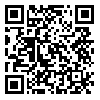BibTeX | RIS | EndNote | Medlars | ProCite | Reference Manager | RefWorks
Send citation to:
URL: http://jdisabilstud.org/article-1-3655-en.html
2- Assistant Professor, Department of Motor Behavior, CT.C., Islamic Azad University, Tehran, Iran
3- Assistant Professor, Department of Physical Education, YI.C., Islamic Azad University, Tehran, Iran
Abstract
Background & Objectives: There is a specific and critical period for social development, during which the basis of social behaviors must be formed in the child, and only after that can they establish appropriate social interactions. Autism is a neurodevelopmental disorder that begins in childhood and affects 1 in 5 children, and at the same time, its prevalence continues to increase. Healthy children naturally participate in motor activities, but it has been observed that autistic children do not participate properly in motor activities and group games. As a result, they are unable to progress in most developmental areas. Interventions related to games and physical activities in autistic children can change their challenging behaviors, resulting in a shift from these behaviors to more positive ones. The findings also show that acquiring play skills early in life may prevent the increase in challenging behaviors in autistic children. The present study aimed to compare the effect of a functional training program and selected physical activity on the social development of children with autism spectrum disorders.
Methods: The present research employed a quasi–experimental design with a pretest–posttest approach and a control group. The statistical population of the study included all children aged 8–10 years with autism disorder living in Zanjan City, Iran, during the academic year 2024–2025. In this study, 36 children with autism disorder were selected as samples using purposive sampling based on the Autism Spectrum Assessment Questionnaire from the autism treatment center and schools in the city. After meeting the inclusion criteria, they were randomly assigned to three groups of 12 people: the selected physical activity group, the functional training group, and the control group. The inclusion criteria for the subjects in the study were as follows: age range of 8–10 years; diagnosis of high–functioning autism by a psychiatrist and through the Autism Spectrum Assessment Questionnaire, having a health record indicating the absence of specific physical and mental illnesses, having healthy vision and hearing, not participating in organized sports, and obtaining parental consent. The exclusion criteria for the study subjects included not participating in the pretest and posttest, missing more than two training sessions, and receiving other interventions such as play therapy, psychotherapy, or medication to reduce autism symptoms. The parents signed the informed consent form. The purpose of the study is stated in this consent form. In addition to respecting the confidentiality of the information, participants may refuse to continue participating in the study at any time if they wish.
After grouping, children participated in a pretest, which included the Social Skills Rating System (SSRS)–Parents Form (Gresham & Elliott, 1990). Then, the training groups practiced for six weeks, three days a week (45 minutes per session), for a total of 18 sessions, as outlined in the desired training program. The control group did not receive a specific training program during this period and continued with their daily activities. At the end of the training period, all three groups participated in a posttest (similar to the pretest). To analyze the data, analysis of covariance and Bonferroni post hoc test were used at a significance level of 0.05 using SPSS version 24 software.
Results: The results showed that both the functional exercise program and selected physical activity methods had a significant effect on the social development of children with autism spectrum disorder. Both methods of selected physical activity exercises (p < 0.001) and functional exercises (p<0.001) improved the social development of children with autism spectrum disorder. Additionally, when comparing the two groups, the findings revealed no significant difference in the effect of selected physical activity and functional exercises on the social development of children with autism spectrum disorder (p=0.990).
Conclusion: The present findings indicate the effectiveness of the intervention methods, including a functional exercise program and selected physical activity, on the social development of children with autism spectrum disorder. Thus, no superiority was observed in favor of either method when comparing the two.
| Rights and permissions | |
 |
This work is licensed under a Creative Commons Attribution-NonCommercial 4.0 International License. |



